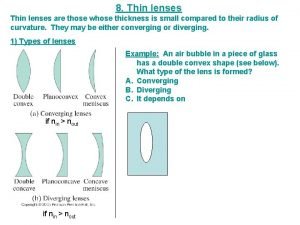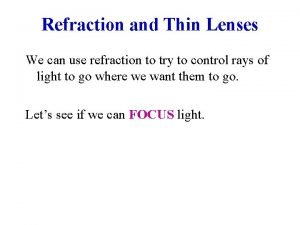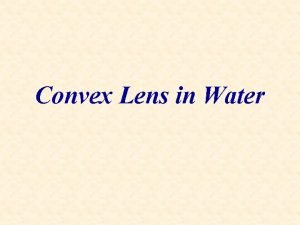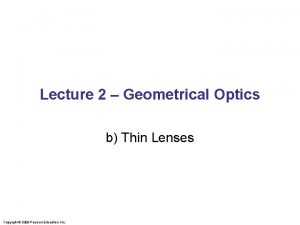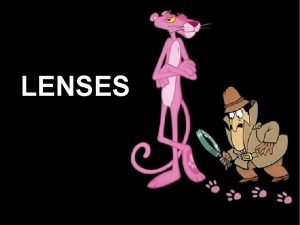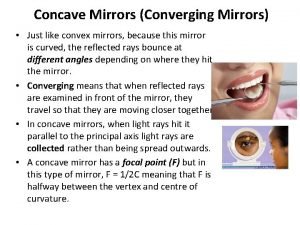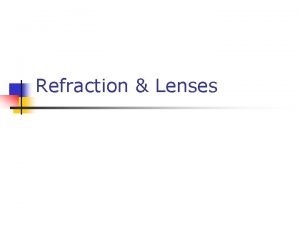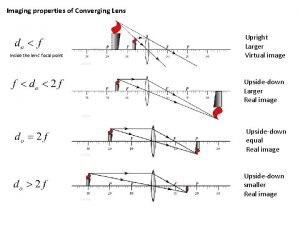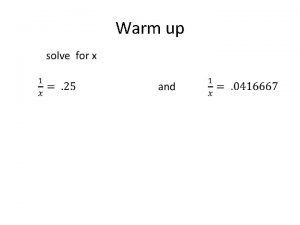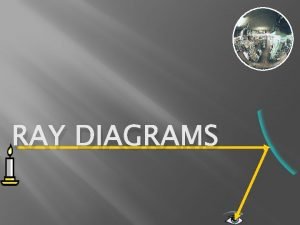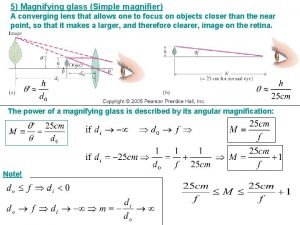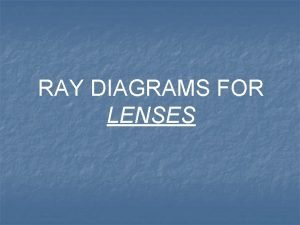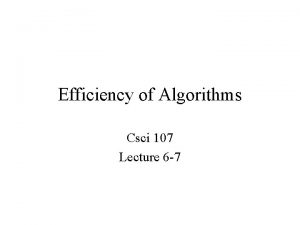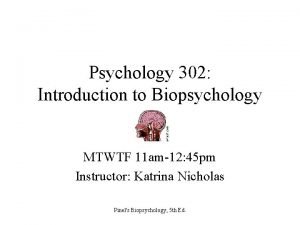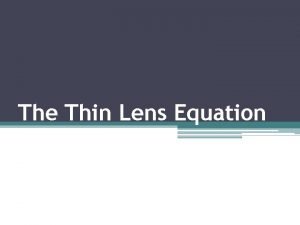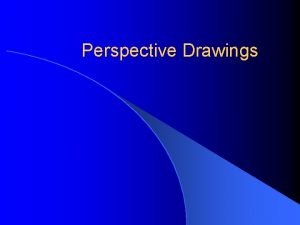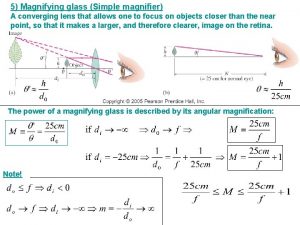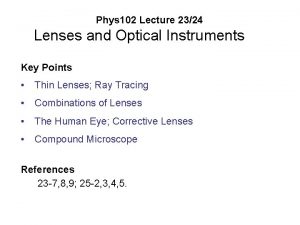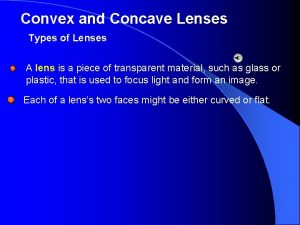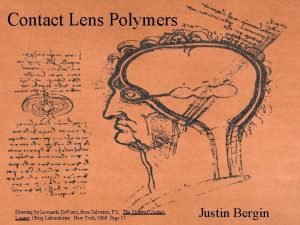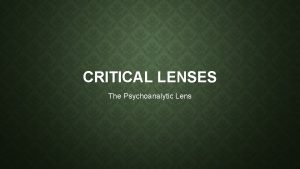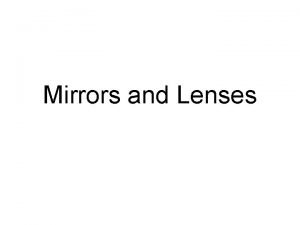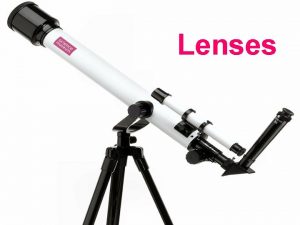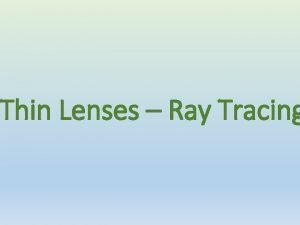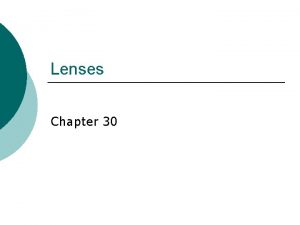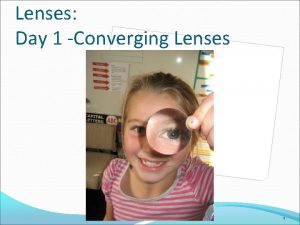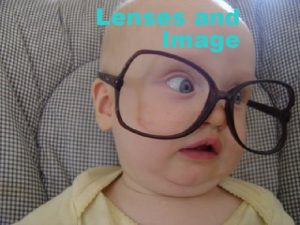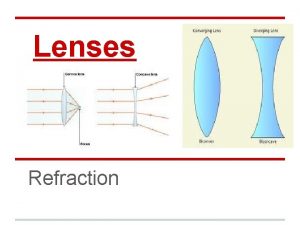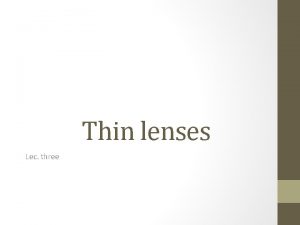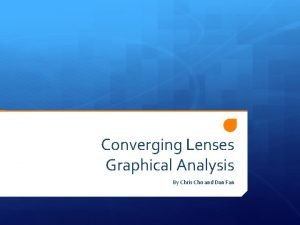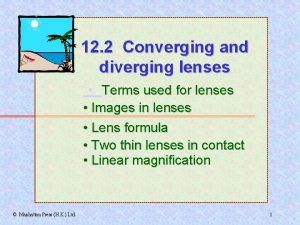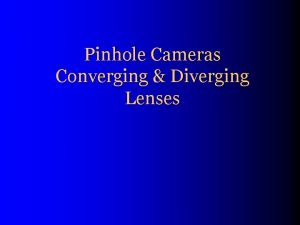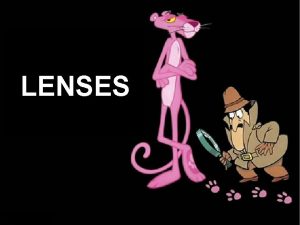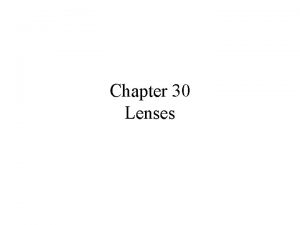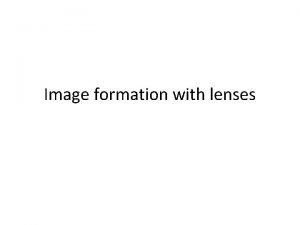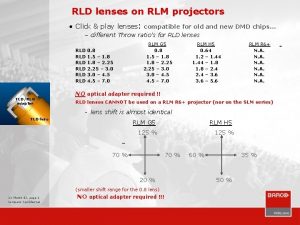Thin Lenses f 5222021 1 Thin Lenses Converging






























- Slides: 30

Thin Lenses f 5/22/2021 1

Thin Lenses: Converging Lens C 2 F 1 r 2 F 2 C 1 f r 1 • Parallel rays refract twice • Converge at F 2 a distance f from center of lens • F 2 is a real focal pt because rays pass through • f > 0 for real focal points 2

Thin Lenses: Diverging Lens f < 0 for virtual focal points C 1 F 2 F 1 C 2 Extension f r 1 r 2 • Rays diverge, never pass through a common point • F 2 at a distance f • F 2 is virtual focal point 3

Images from Thin Lenses O C 2 C 1 F 1 I f r 1 r 2 s 5/22/2021 s’ 4

Images from Thin Lenses I O F 1 f s’ s 5/22/2021 5

Images from Thin Lenses O C 1 F 2 C 2 s’ r 1 s 5/22/2021 r 2 6

Locating Images by Drawing Rays 1 O 3 F 1 2 F 2 I 1. Ray initially parallel to central axis will pass through F 2. 2. Ray passing through F 1 will emerge parallel to the central axis. 3. Ray passing through center of lens will emerge with no change in direction because the ray encounters the two sides of the lens where they are almost parallel. 5/22/2021 7

Locating Images by Drawing Rays 2 I F 1 1 F 2 O 3 1. Ray initially parallel to central axis will pass through F 2. 2. Backward extension of ray 2 passes through F 1 3. Ray 3 passes through center of lens will emerge with no change in direction. 5/22/2021 8

Locating Images by Drawing Rays 1 O 2 F 2 I F 1 3 1. Backward extension of ray 1 passes through F 2 2. Extension of ray 2 passes through F 1 3. Ray 3 passes through center of lens will emerge with no change in direction. 5/22/2021 9

Two Lens System Note: If image 1 is located beyond lens 2, s 2 for lens 2 is negative. Lens 1 Lens 2 O s 1 1. Let s 1 represent distance from object, O, to lens 1. Find s 1’ using: 2. Ignore lens 1. Treat Image 1 as O for lens 2. 3. Overall magnification: 5/22/2021 10

Example: Two Lens System A seed is placed in front of two thin symmetrical coaxial lenses (lens 1 & lens 2) with focal lengths f 1=+24 cm & f 2=+9. 0 cm, with a lens separation of L=10. 0 cm. The seed is 6. 0 cm from lens 1. Where is the image of the seed? Lens 1: Image 1 is virtual. Lens 2: Treat image 1 as O 2 for lens 2. O 2 is outside the focal point of lens 2. So, image 2 will be real & inverted on the other side of lens 2. 5/22/2021 Image 2 is real. 11

Example Figure f 1 Lens 2 f 2 O s 1 L 5/22/2021 12

Table for Lenses Lens Type Object Location Image Type Image Orientation Sign of f, s’, m Converging Inside F Same side as object Virtual Same as object +, -, + Converging Outside F Side of lens opposite Real the object Inverted +, +, - Diverging Anywhere Same side as object Same as object -, -, + 5/22/2021 Virtual 13

Quiz lecture 25 O I C The radius r in the formula is: A. Positive B. Negative O C 5/22/2021 I A. Positive B. Negative 14

Quiz lecture 25 The radius r in the formula is: r O C n 1 5/22/2021 I C n 2 n 1 O A. Positive B. Negative r I A. Positive B. Negative n 2 15

Quiz lecture 25 The focal length f in the formula is: A. Positive B. Negative 5/22/2021 16

LECTURE 26: Interference http: //www. sonic. net/~ideas/graphics/mma_cd. gif http: //content. answers. com/main/content/img/CDE/_CDVSDVD. GIF http: //electronics. howstuffworks. com/cd 1. htm

Interference When two waves with the same frequency f and wavelength combine, the resultant is a wave whose amplitude depends on the phase different, . 5/22/2021 18

Interference: Phase Differences Constructive Interference Destructive Interference = 0 or 1 = 0. 5 = 0. 3 5/22/2021 19

Coherence *If the difference in phase between two (or more) waves remains constant ( i. e. , time-independent), the waves are said to be perfectly coherent. *A single light wave is said to be coherent if any two points along the propagation path maintains a constant phase difference. *Coherence length: the spatial extent over which a light wave remains coherent. Only coherent waves can produce interference! 5/22/2021 20

Coherence Infinite coherence length Finite coherence length 5/22/2021 Single Photon 21

Intensity of Two Interfering Waves *Two light waves not in phase: 5/22/2021 22

Intensity of Two Interfering Waves *Maxima occur for: for m = 0, 1, 2, 3…. *Minima occur for: 5/22/2021 23

Interference *Three ways in which the phase difference between two waves can change: 1. By traveling though media of different indexes of refraction 2. By traveling along paths of different lengths 3. By reflection from a boundary 5/22/2021 24

Quiz lecture 25 The light waves of the rays in the figure have the same wavelength and are initially in phase. If 7. 60 wavelengths fit within the length of the top layer and 5. 50 wavelengths fit within that of the bottom layer, which layer has the greater index of reflection? ntop nbottom L 5/22/2021 (A) top layer (B) bottom layer (C) ntop = nbottom 25

Interference: Different Indexes of Refraction *The phase difference between two waves can change if the waves travel through different material having different indexes of refraction. n 1 n 2 L 5/22/2021 26

Interference: Different Path Lengths *The phase difference between two waves can change if the waves travel paths of different lengths. Thomas Young experiment (1801) Remember Huygen’s principle. 5/22/2021 27

Interference: Different Path Lengths *The phase difference between two waves can change if the waves travel paths of different lengths. 5/22/2021 28

Interference: Different Path Lengths *The phase difference between two waves can change if the waves travel paths of different lengths. 5/22/2021 29

Interference: Different Path Lengths *The phase difference between two waves can change if the waves travel paths of different lengths. Spacing between fringes: 5/22/2021 30
 Thin converging lens
Thin converging lens What kind of shape
What kind of shape Wegstein method
Wegstein method Converging lens in water
Converging lens in water Steam temp
Steam temp Converging lens equation
Converging lens equation Convex shape image
Convex shape image Converging-diverging
Converging-diverging Concave mirror converging or diverging
Concave mirror converging or diverging Diverging lens ray diagram
Diverging lens ray diagram Ridge ending fingerprint
Ridge ending fingerprint Converging operations psychology example
Converging operations psychology example Image formed by lenses
Image formed by lenses Converging lens equation
Converging lens equation Converging pointers algorithm
Converging pointers algorithm Concave is converging or diverging
Concave is converging or diverging Simple magnifier formula
Simple magnifier formula Converging lines diagram
Converging lines diagram Converging pointers algorithm
Converging pointers algorithm Converging operations psychology example
Converging operations psychology example Converging ils approaches
Converging ils approaches Thin lens equation example
Thin lens equation example Horizontal line art definition
Horizontal line art definition Simple magnifying glass
Simple magnifying glass Shuffle left algorithm
Shuffle left algorithm Nearsightedness
Nearsightedness Convergent plate boundary
Convergent plate boundary Converging lens is concave or convex
Converging lens is concave or convex Contact lens drawing
Contact lens drawing Psychoanalysis lens
Psychoanalysis lens Mirrors and lenses
Mirrors and lenses
